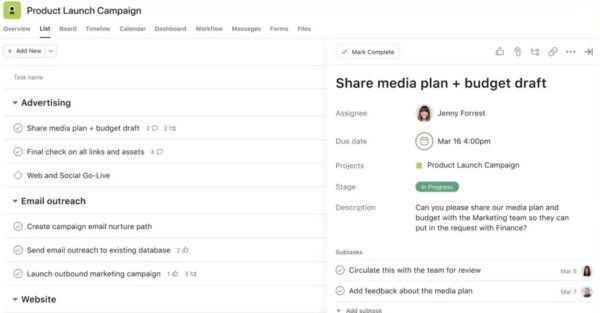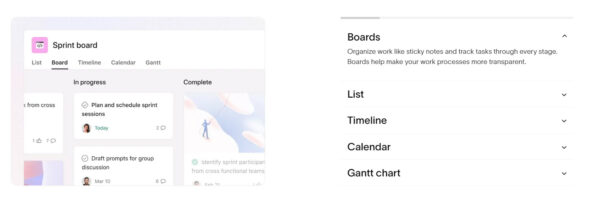Asana project management software is a well-recognized tool. With its features and functionality, you can achieve greater project clarity and stay on top of your tasks like never before. This powerful platform provides a user-friendly interface that allows you to create an account, access the Asana login page, assign tasks, set due dates, track progress, and collaborate with your team in real-time. Our Asana user guide will help you master your tasks and achieve greater project clarity.
By mastering Asana project management software, you can streamline your workflow, eliminate confusion, and ensure that everyone is on the same page. Whether you’re managing a small team or a large-scale project, Asana offers the tools and features you need to stay organized and focused. No more missed deadlines and miscommunication. Asana provides enhanced productivity and efficiency.
Setting Up Your Workspace
Getting started with Asana project management software is quick and easy. Create an account, go to the Asana login page, set up your workspace, and add projects and tasks. Asana offers a variety of templates to help you get started, or you can create your own projects from scratch. Once you’ve set up your workspace, you can invite team members to join and start collaborating right away.
Customizing your Asana workspace is intuitive. You can create custom fields, tags, and priorities to help you organize your tasks and projects in a way that makes sense for you. You can also set up notifications and reminders to keep you on track and ensure that you never miss a deadline. Asana’s customizable dashboard allows you to see all of your tasks and projects in one place so you can prioritize your work and stay focused.
Asana project management software offers integrations with a wide range of other productivity tools, such as Slack, Google Drive, and Microsoft Teams. This allows you to streamline your workflow and access all of your important information in one place. By connecting Asana with your other tools, you can save time and reduce the risk of errors caused by manual data entry.
Creating and Organizing Tasks

(Image source: Asana)
You can create and add tasks to projects, assign them to team members, and set due dates with just a few clicks. You can also add descriptions, attachments, and comments to tasks to provide additional context and information for your team members. Asana’s task templates help you create recurring tasks, so you never have to worry about forgetting an important deadline.
Organizing tasks in Asana is just as easy. You can create sections within projects to group related tasks together, making it straightforward to see the progress of each phase of your project at a glance.
Tags and custom fields can be used to categorize and prioritize your tasks further. Asana’s drag-and-drop interface helps you rearrange tasks and projects as needed, allowing you to adapt to changing priorities and deadlines.
Asana project management software also offers advanced search and filtering capabilities so you can quickly find the tasks you’re looking for and focus on what’s most important. You can save custom searches and create reports to track your team’s progress and identify areas where you may need to make adjustments. Asana’s task dependencies feature ensures that tasks are completed in the correct order so you can avoid bottlenecks and keep your project on track.
Utilizing Project Management Features

(Image source: Asana)
Asana offers a variety of project management features to help you stay organized and focused. One key feature is its project timelines, which allow you to see the start and end dates of each task in your project. You can set dependencies between tasks to ensure that they are completed in the correct order, and you can adjust deadlines and priorities as needed to keep your project on track.
Available project templates can also be used to create new projects quickly and easily. These templates include pre-made tasks, sections, and deadlines that you can customize to suit your project’s needs. Asana also offers project portfolios, which allow you to group related projects together and see an overview of all of your team’s work in one place.
Asana’s project management features also include task dependencies, which allow you to link tasks together so that one task cannot be completed until another is finished. This helps to ensure that your project progresses smoothly and that tasks are completed in the correct order. Asana also offers milestones, which allow you to mark key points in your project timeline and track your progress toward your goals.
Collaborating and Communicating with Your Team
Collaboration is key to project success, and Asana makes it easy to communicate and collaborate with your team in real-time. You can leave comments on tasks, tag team members, and share files within the platform so everyone has access to the information they need to complete their tasks. Asana’s Inbox feature allows you to see all of your notifications and updates in one place, so you never miss an important message.
Team pages are available and allow you to see all of the projects and tasks that your team is working on. This makes it simple to see who is working on what, and to ensure that everyone is on the same page. Asana’s project conversations feature allows you to have discussions within specific projects, so you can keep all of your project-related communication in one place.
Asana project management software also offers integration with communication tools like Slack and Microsoft Teams, so you can switch between platforms and keep all of your important information in one place. By integrating Asana with your communication tools, you can streamline your workflow and reduce the risk of miscommunication caused by switching between platforms.
Tracking Progress and Staying Focused with Task Management Tools
![]()
(Image source: Asana)
Tracking progress and time is essential for project success, and Asana offers a variety of task management tools to help you stay on top of your tasks and deadlines. Asana’s progress tracking feature allows you to see the status of each task at a glance, so you can quickly identify any tasks that are behind schedule or at risk of missing their deadline. You can also set up notifications and reminders to keep you on track and ensure that you never miss an important deadline.
Asana project management software offers reporting and analytics tools that allow you to track your team’s progress and identify areas where you may need to make adjustments. You can create custom reports to see how your team is performing against key metrics, and you can use this information to optimize your workflow and improve productivity. Asana’s task dependencies feature ensures that tasks are completed in the correct order so you can avoid bottlenecks and keep your project on track.
Task management tools also include calendar views, which allow you to see all of your tasks and deadlines in a calendar format. This makes it easy to visualize your workload and prioritize your tasks accordingly. You can also set up recurring tasks and reminders to ensure that you never miss an important deadline, and you can use Asana’s drag-and-drop interface to rearrange tasks and projects as needed quickly.
Integrating with Other Productivity Tools and Software
Asana offers integrations with a wide range of other productivity tools and software, allowing you to streamline your workflow and access all of your important information in one place. By integrating Asana with tools like Slack, Google Drive, and Microsoft Teams, you can reduce the risk of errors caused by manual data entry and ensure that all of your information is up-to-date and accessible to your team.
One key benefit of integrating Asana with other tools is the ability to automate repetitive tasks and processes. For example, you can set up triggers and actions in Asana to automatically create tasks when certain conditions are met or to send notifications to team members when a task is completed. This can save you time and reduce the risk of human error caused by manual data entry.
Asana also offers integrations with time-tracking tools, invoicing software, and project management platforms, allowing you to create a seamless workflow that meets all of your project management needs. By integrating Asana with your other tools, you can save time and improve efficiency, allowing you to focus on what matters most – completing your projects on time and on budget.
ALSO READ: ACCELERATE YOUR TEAM PRODUCTIVITY: HOW TRELLO CAN REVOLUTIONIZE YOUR WORKFLOW
Tips and Tricks for Maximizing Productivity with Asana
To get the most out of Asana project management software and achieve greater project clarity, consider implementing the following tips and tricks:
- Use project templates to create new projects and tasks quickly.
- Take advantage of Asana’s keyboard shortcuts to navigate the platform more efficiently.
- Set up recurring tasks for routine activities to save time and ensure nothing falls through the cracks.
- Use Asana’s custom fields and tags to categorize further and prioritize your tasks.
- Regularly review and update your projects and tasks to ensure that you stay on track and meet your deadlines.
- Leverage Asana’s reporting and analytics tools to track your team’s progress and identify areas for improvement.
By following these tips and tricks, you can maximize your productivity with Asana and ensure that your projects are completed on time and on budget. With Asana’s powerful features and user-friendly interface, you can streamline your workflow, eliminate confusion, and achieve greater project clarity than ever before.
Plans and Pricing
For individuals and small teams
- Personal – For individuals and small teams looking to manage their tasks – $0
- Starter – For growing teams that need to track their projects’ progress and hit deadlines – $10.99 US per user, per month billed annually, $13.49 US billed monthly.
- Advanced – For companies that need to manage a portfolio of work and goals across departments – $24.99 US per user, per month billed annually, $30.49 US billed monthly.
Business and Enterprises
- Enterprise – Contact sales for pricing
- Enterprise+ – Contact sales for pricing
ALSO SEE JIRA SOFTWARE ATLASSIAN: HOW TO USE IT EFFECTIVELY IN YOUR PROJECTS + CASE STUDIES
The Power of Asana for Achieving Project Clarity and Staying Focused
Asana is a powerful task management tool that offers a wide range of features to help you achieve greater project clarity and stay focused. By mastering Asana project management software, you can streamline your workflow, eliminate confusion, and ensure that everyone is on the same page. Whether you’re managing a small team or a large-scale project, Asana offers the tools and features you need to stay organized and focused.
With Asana’s project management features, collaboration tools, and task management tools, you can track progress, communicate with your team, and ensure that your projects are completed on time and on budget. By integrating Asana with other productivity tools and software, you can create a seamless workflow that meets all of your project management needs. Say goodbye to missed deadlines and miscommunication, and say hello to enhanced productivity and efficiency with Asana.

